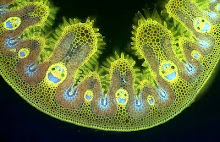It's understandable that people admire Sarracenia plants for their funnel-shaped pitfall traps that catch and drown insects but in many ways their flowers are equally remarkable..... and their purpose is to lure insects for pollination rather than as a food source, so this is a Jekyll-and-Hyde plant. Each flower consists of five sepals that expand as the bud opens, arching downwards above the rest of the floral structure.
Below hang five petals, shaped like tongues, protruding from gaps in the weird, inverted umbrella-shaped stigma that is suspended from a style in the centre of the flower that leads to the ovary and ovules (hidden from view in these photographs). There's a very fine cutaway illustration here that identifies all the key structures. Bees crawl along the petal and in through those curved indentations that you can see around the edge of the 'inverted umbrella'. Once inside they collect pollen or deliver it to the tips of one of the five receptive stigmas that are at the apex of each of the upwards curving, greenish bands of thickening visible between the petals. It can be quite a struggle for the bees to force their way in and out again.
When they are in full flower the blooms have a scent that's reminiscent of a bed of stinging nettles on a hot summer's day, although in the green-flowered species above (Sarracenia flava) it smells of cat urine - which must be attractive to bees but makes this plant unsuitable for growing on your kitchen windowsill.
The flowers appear in spring, before a new crop of pitchers is produced, and in the bud stage they're reminiscent of a rather elegant art deco lamp. The flowers are a nectar source for bees but the pitchers are also a potential death trap, so the blooms are elevated in long stems well above the deadly pitchers. The scent of the flowers seems to be a powerful attractant to bees - if I leave my conservatory doors open during the flowering period, in early spring, the room soon fills with eager bumblebees, newly emerged from hibernation and desperate to get at the flowers.
Sarracenia species are native to North America. Some species are hardy (although the winter we've just had will have put that statement to the test) and S.purpurea is naturalised in the wild in Ireland and in the Lake District.
For more information about carnivorous plants take a look at http://www.thecps.org.uk/

















